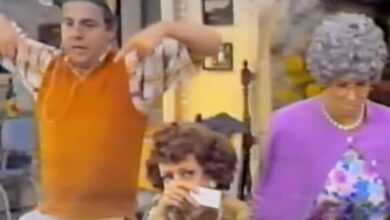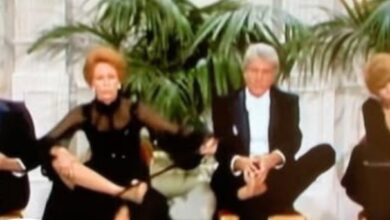Marching Band Delivers an Extraordinary Tribute to the King of Pop
Among the most spectacular musical tributes ever seen, one performance continues to stand out — a marching band performing a massive, field-sized moonwalk in honor of the King of Pop. For anyone unfamiliar with American college football, halftime isn’t just an intermission between plays; it’s a showcase of creativity and spectacle, often featuring enormous marching bands whose productions rival Broadway performances in complexity and spirit.
Each major team in the United States has its own traditions, but few can match the visual and musical precision of The Ohio State University Marching Band. Their intricate formations, flawless timing, and theatrical flair have made them a global internet phenomenon. Fans and critics alike have dubbed them “The Best Damn Band In The Land,” a title that has become synonymous with excellence and innovation in collegiate music performance.
Over the years, the Ohio State band has delivered numerous halftime shows that left audiences stunned, but none resonated quite like their jaw-dropping tribute to Michael Jackson. This breathtaking performance fused athletic discipline, artistic vision, and a deep appreciation for pop music’s greatest performer. It wasn’t just a show — it was a cultural event that united generations under the sound of Jackson’s timeless hits, interpreted in marching-band form.
The tribute was designed as a celebration of Michael Jackson’s extraordinary career and the 25th anniversary of his legendary “Bad” album. From its very first notes, it was clear that the performance would go beyond simple homage. Every move, every beat of the drums, and every horn blast captured Jackson’s signature flair for drama, rhythm, and showmanship — creating a living, breathing monument to the enduring power of his music.
As the musicians took the field, the band’s formation began to shift and swirl until it became a massive, entwined “M” and “J,” echoing Michael Jackson’s iconic logo. The precision required to execute this in perfect alignment is hard to imagine; hundreds of students moving as one cohesive body, creating a lettered symbol that pulsed in sync with the rhythm. The audience erupted immediately — the sight was both nostalgic and electrifying, a signal that something unforgettable was unfolding.
From there, the medley carried fans through an exhilarating journey of Jackson’s greatest hits. Each formation represented another era, another dance move, another global anthem. Songs like “Bad,” “The Man in the Mirror,” and “The Way You Make Me Feel” echoed across the stadium as the crowd clapped, sang, and cheered in time with the music. The musicians were no longer just a band — they were storytellers, breathing life into decades of pop history through rhythm and motion.
By this point, the audience was already mesmerized. Even fans from Iowa, Ohio State’s rivals for the day, couldn’t help but join in the cheers. The coordination between music and motion was astonishing — hundreds of musicians hitting every note and step with machine-like precision. Yet, just when it seemed the performance had reached its pinnacle, the band unleashed a visual surprise so extraordinary that it would go on to be viewed millions of times across the world.
As the familiar beat of “Billie Jean” filled the air, the marching band transformed into something straight out of a dream. Piece by piece, their movements revealed a massive figure — Michael Jackson himself — complete with the unmistakable single white glove. Then, in a moment that silenced the entire stadium before erupting in cheers, the giant formation began to move. The figure moonwalked across the field in perfect rhythm, recreating Jackson’s most iconic move on an unimaginable scale.
It’s almost impossible to comprehend the precision needed to make such an illusion work. Every member of the band had to march, pivot, and play in perfect timing to create the illusion of motion. From the stands, it looked effortless — as though a single massive entity was gliding backward across the turf. In reality, it was the result of months of planning, relentless rehearsal, and a shared commitment to artistic perfection that few other collegiate ensembles could achieve.
The emotional response from the crowd was overwhelming. Thousands of people — students, alumni, parents, and even rival fans — rose to their feet, united by awe and admiration. It was more than nostalgia; it was witnessing the impossible become real through human precision and imagination. The roar that followed the moonwalk moment shook the stands, solidifying this show as one of the most iconic halftime performances in sports history.
Technically, the show was a masterpiece. But it also carried deeper meaning — a heartfelt connection between generations who grew up dancing to Michael Jackson’s music and a new wave of performers who honored that legacy through creativity and discipline. The band didn’t just replicate the pop star’s movements; they captured the feeling of wonder his performances inspired, translating them into the universal language of music and motion.
When the footage hit the internet, it spread like wildfire. Clips circulated across social media, news outlets, and TV shows worldwide. Millions watched in disbelief, marveling that a college marching band had pulled off something so cinematic. Within days, the video became a viral phenomenon, earning global attention and introducing new audiences to the tradition of halftime artistry that had long been a cornerstone of American college sports.
Even years later, people still revisit that performance with the same excitement they felt the first time. Every note, every formation, every step remains a perfect blend of athleticism and art. The Ohio State Marching Band had proven that music can transcend boundaries — that even on a football field, you can find moments of pure artistic brilliance that honor legends while creating new ones in the process.
The tribute endures as one of the finest examples of what collaboration, passion, and imagination can achieve. By transforming a simple halftime routine into a global event, the Ohio State Marching Band reminded the world that great art doesn’t always come from recording studios or concert halls. Sometimes, it rises from a field of marching musicians under open skies — carrying the unmistakable rhythm of the King of Pop himself.





